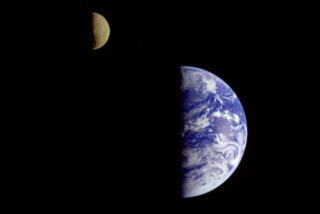Massive asteroid QE2 is traveling with its own moon
- Share via
When asteroid 1998 QE2 makes its closest approach to Earth on Friday, it will not be traveling alone: The massive space rock is hurtling through space accompanied by its own moon.
It is not unheard of for an asteroid to have a moon, or satellite, accompanying it on its journey, but it is rare. Just 16% of asteroids that are 655 feet across or larger are part of a binary or triple system, according to the Jet Propulsion Laboratory in Pasadena.
Asteroid 1998 QE2’s moon was revealed when NASA scientists were finally able to get a closer look at the incoming asteroid using the 230-foot Deep Space Network antenna at Goldstone, Calif.
ASTEROID QUIZ: Test your space rock knowledge
Radar images indicate that the body of the main asteroid is about 1.6 miles in length, while its moon is an estimated 2,000 feet in length -- a little more than one-third of a mile.
The asteroid that exploded over the Russian town of Chelyabinsk was just 55 feet in diameter.
Early radar views of asteroid 1998 QE2 also indicate it is spinning -- completing a full rotation in less than 4 hours, and that it has several large divots on its surface.
There is no reason to fear that either the asteroid or its moon will strike the Earth. The two will make their closest approach to our planet on May 31 at 1:59 PDT, but even then they will still be 3.6 million miles from the Earth, or 15 times farther than the moon.
Scientists say Asteroid 1998 QE2 won’t pass this close to Earth again for at least 200 years, and nothing in its orbit suggests it will ever hit us.
That is a good thing, because an impact with an asteroid this size could lead to global extinction.
Scientists will continue to use the Deep Space Network antenna, and the Arecibo Observatory in Puerto Rico to closely track the asteroid through June 9.






